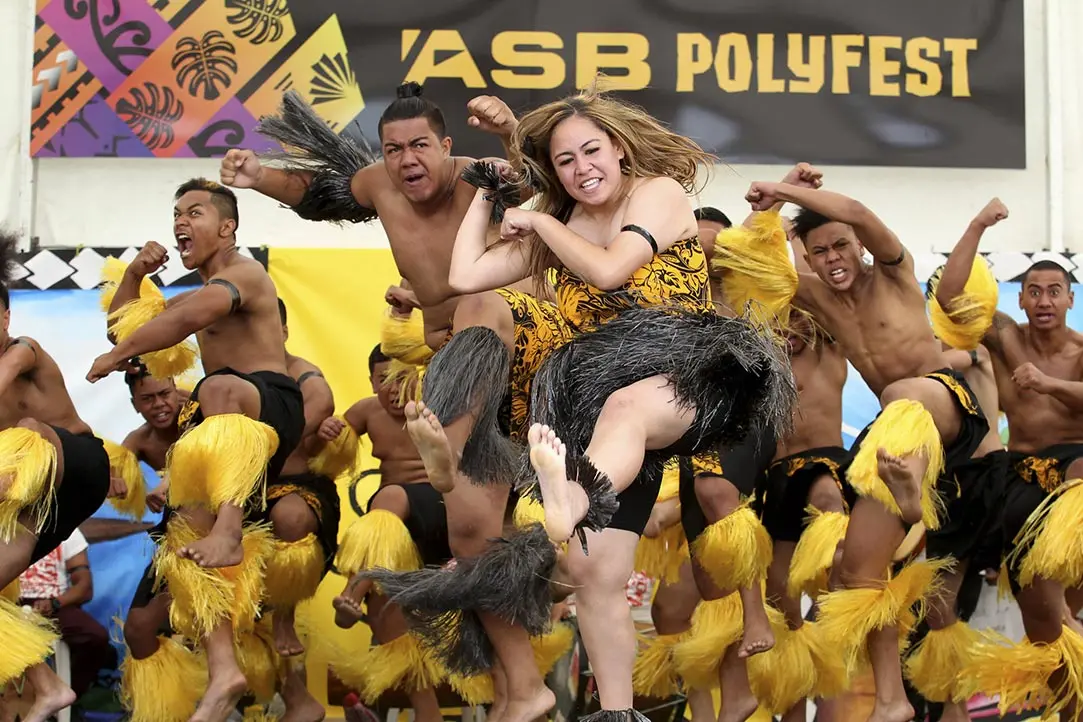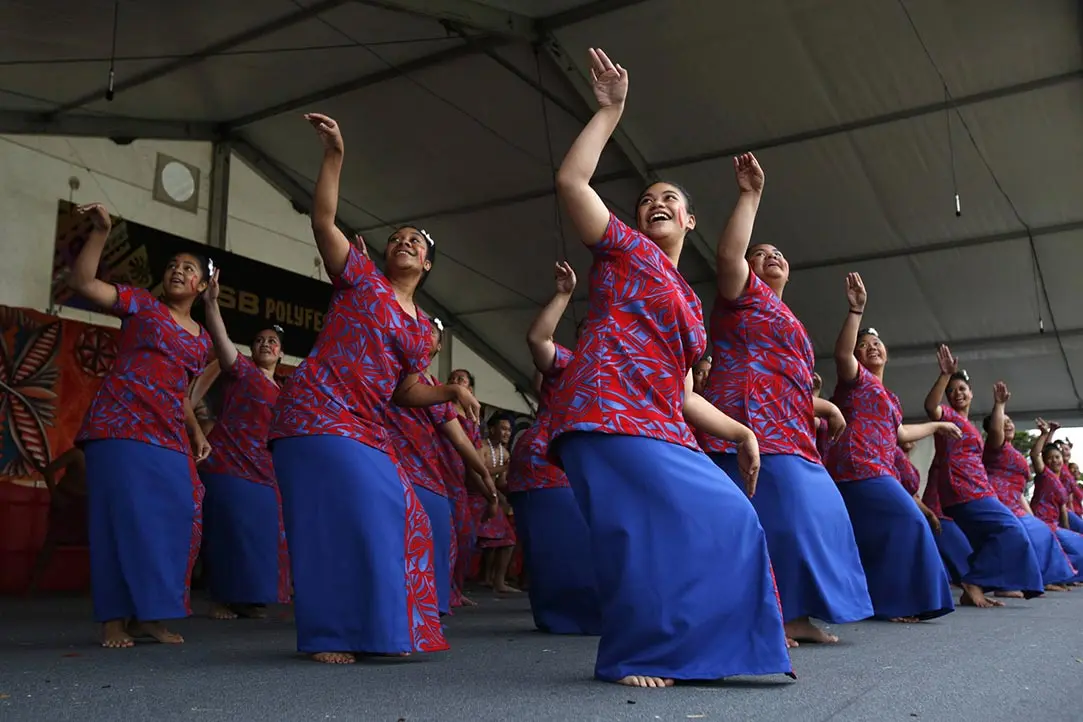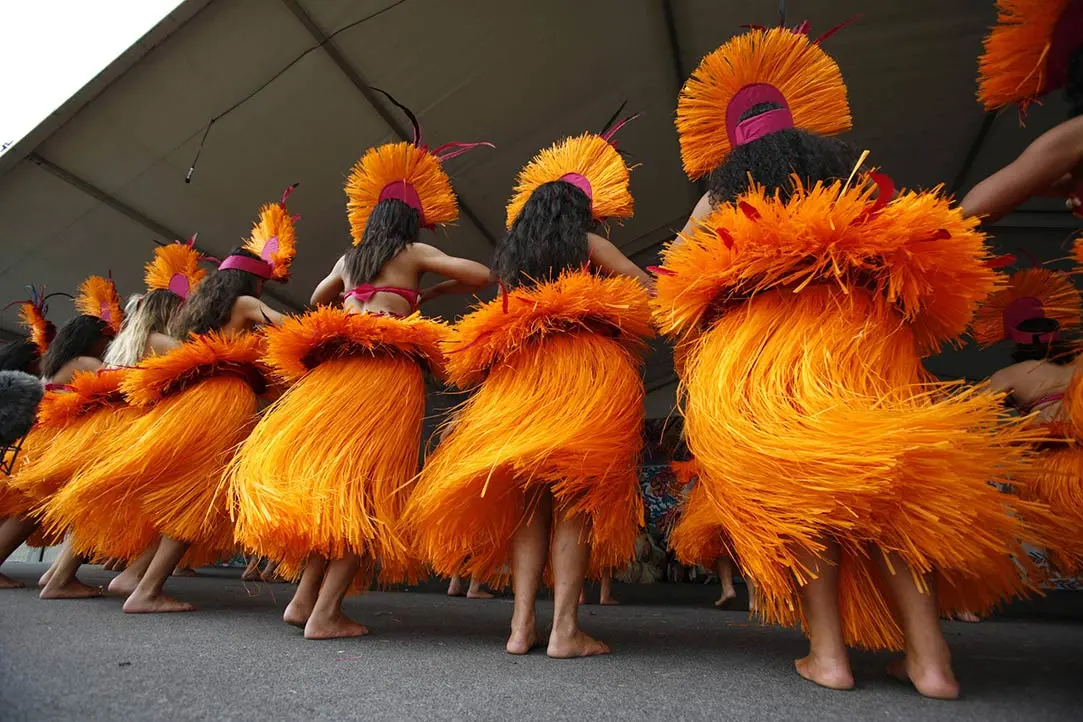Polyfest — reconnecting youth to their languages
ASB Polyfest is one of the largest Pacific festivals in the world with thousands of people attending an explosion of Pacific cultures. Learn about this festival, its history and ways we can support Pacific communities to reconnect to their languages.

Image credit: Edgewater College, Siva performance at ASB Polyfest, 2015 by Smita Biswas. Ref: POLY-D-2015-316 Auckland Libraries Heritage Collections. CC BY.
Reconnecting to languages
As a celebration of culture erupts on the stages of the Manukau Sports Bowl, it is hard to believe that there is a decline in Pacific languages amongst the younger generation in Aotearoa New Zealand.
Since Polyfest's establishment, the festival's objective has always been ‘to demonstrate the pride of cultural identity, and to bring schools and the different cultures between them, together’. Something the festival has more than achieved in its 48-year history.
The story of Pacific languages in Aotearoa New Zealand starts with a long history of cultural and genealogical ties throughout Te Moana Nui a Kiva (The Great Ocean of Kiva — the Pacific Ocean). Pacific languages have very complex origins with linguists still debating on what languages belong to which language groups. This speaks to the number of unique and distinctive languages across the Pacific.
Languages fall under the umbrella term of ‘cultural identity’. The term refers to a person's sense of belonging, sense of awareness and shared beliefs. Pacific societies consider languages an important measure of culture and identity. By embracing your language one can:
trace ancestry
reclaim land and property
understand values and tradition
reconnect to nature and the supernatural.
Shifting the dynamics of Pacific languages
Pacific languages today have been affected by the influences of Christianity and mass migration. With the arrival of Christianity to the Pacific, languages that were once only spoken were now written and printed on paper for reading.
This shift came with many complications. For instance, letters were borrowed from the English alphabet in documents such as the Holy Bible and other religious publications. Many Pacific languages today are full of transliterated words that came during the shift from oral to written.
To see an example of how Pacific languages have evolved, view this video The Pepa Trail (YouTube, 13:39) from Auckland Libraries.
Mass migration had severe impacts on Pacific languages as families moved into different social and cultural environments. Migration was influenced by the promise of financial safety and the duty of service that drives most Pacific families. Families would migrate with the belief that English was the only pathway to success.
By pushing their children to learn English, Pacific languages lost their importance. Success grew for many families as Pacific languages declined. Languages had to adapt to new environments if they wanted to survive.
Combatting the shift
With the constant changes and outside influences throughout history, Pacific languages have evolved to meet the demands of a new generation of adults and youth. Pacific communities who live away from their island homelands have pooled together to create artistic ways for languages to survive the effects of colonisation and migration.
Festivals such as ASB Polyfest, TuTagata Polynesian Festival and Pasifika Festival originated with similar principles of strengthening cultural identity and reconnecting Pacific people with their languages.
Revival of our languages
Recently, there has been a real effort to revive Pacific languages amongst the younger generation. Themes supporting cultural identity and awareness have pushed parents, teachers and students to reconnect to languages like never before. Luckily for them, there are a few opportunities in the community to ensure reconnecting to languages is accessible and relatable.
In 1976, an idea for the cultural revitalisation of Pacific song and dance was created out of Hillary College (now known as Sir Edmund Hillary Collegiate) in Ōtara. Students and teachers gathered together to design the foundations of what is now one of the biggest Pacific festivals in the world, Polyfest.
What is Polyfest?
Polyfest is a cultural festival created for secondary students in the Tāmaki Makaurau area. Students prepare to express, wear and present their cultures to their families, communities and spectators throughout the festival.
In preparation for 4 days of intense cultural performances, practices will start at least 7–8 weeks before the event. It is common for practices to run after school and on weekends so students' classes are not disrupted. Volunteer tutors help to compose songs and design dance brackets for students to learn. There are 6 stages representing different islands of the Pacific:
To the community, Polyfest is a beacon of cultural awareness and celebration. For many secondary school students, it is the lashing that connects them to their cultures and languages.
Over the years, festival organisers have faced challenges such as when COVID-19 forced the closure of the event and shifted it to its first-ever live broadcast-only event. For 2023, organisers have promised a bigger, better event with thousands of people estimated to attend over the 4 days.

Image credit: Waitakere College students at ASB Polyfest, 2015 by Smita Biswas. Ref: POLY-D-2015-322 Auckland Libraries Heritage Collections. CC BY.
Ensuring the survival of our languages
Polyfest offers us all a platform to teach and learn languages through participation, listening and performing.
For me, this festival embodies more than just ‘performances’. It carries a history of endangered languages and reconnection. It is the story of the largest Pacific city in the world recognising the importance of cultural identity through oral languages.
One way we can all help ensure the survival of these languages is by supporting Polyfest, whether it be through attendance or participation. Understanding the rich history behind this event and others similar to it will guarantee the event's survival as well as the survival of Pacific languages.

Image credit: Aorere College at ASB Polyfest, 2015 by Smita Biswas. Ref: POLY-D-2015-299 Auckland Libraries Heritage Collections. CC BY-NC.
Resources to explore
Here are some resources to explore Pacific languages.
National Library resources
Explore our collections of books in these Pacific languages:
Borrow books from our lending service
Read about the benefits of books in world languages
These topics from Topic Explorer have quality, curated resources on song and dance across the Pacific and Pacific languages:
Read our blog post on how stories can help preserve our Pacific languages: Weavers of Pacific languages, orators of our stories.
Other resources
Digital Pasifik has videos and images of past Polyfest performances and inspirational blogs about Pacific languages:
TheCoconet.tv has a video of Polyfest alumni telling their stories from when they were the stars of the show: Polyfest Throwback | Time Capsules from Polyfest Alumni.